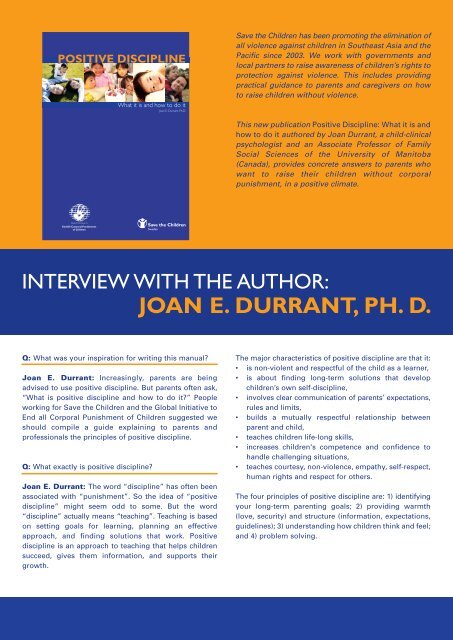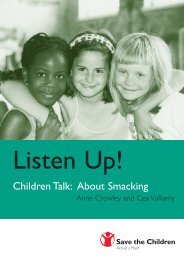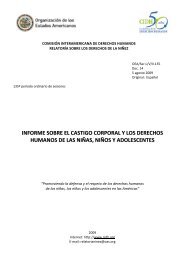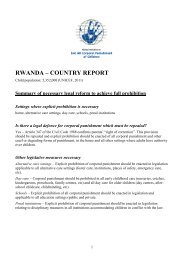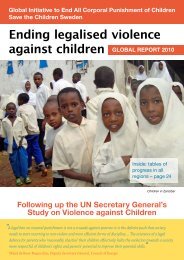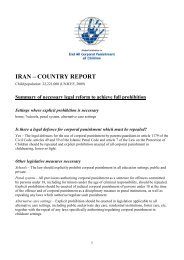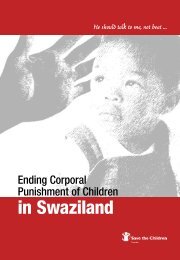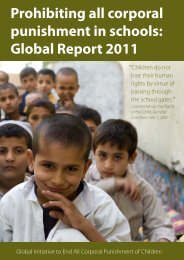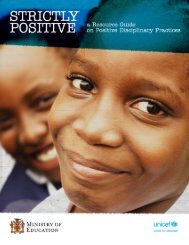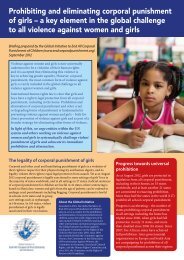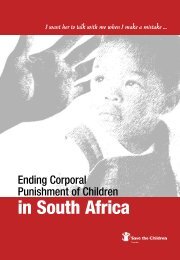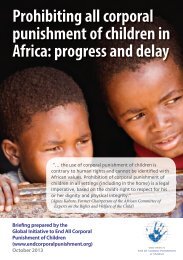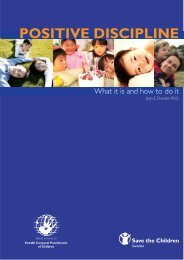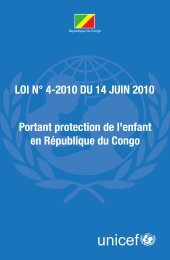Interview with the Author - Global Initiative to End All Corporal ...
Interview with the Author - Global Initiative to End All Corporal ...
Interview with the Author - Global Initiative to End All Corporal ...
Create successful ePaper yourself
Turn your PDF publications into a flip-book with our unique Google optimized e-Paper software.
Q: There are many parenting guides <strong>to</strong> choose from,what makes this one different from <strong>the</strong> o<strong>the</strong>rs?Joan E. Durrant: Simplicity. <strong>All</strong> of <strong>the</strong> research findingson positive discipline are boiled down <strong>to</strong> four basicprinciples that parents can use <strong>to</strong> guide <strong>the</strong>ir interactions<strong>with</strong> <strong>the</strong>ir children.Ano<strong>the</strong>r unique aspect of this guide is <strong>the</strong> opportunity itprovides for practice. It can be very difficult <strong>to</strong> thinkrationally in situations of parent-child conflict. It takeseffort and practice <strong>to</strong> shift from impulsive punitiveresponses <strong>to</strong> thought-out constructive responses in suchsituations. This guide gives parents practice in thinkingthrough <strong>the</strong>ir responses so that <strong>the</strong>y are better preparedwhen difficult situations arise.A third unique feature of this manual is that it interweavesfindings of academic research <strong>with</strong> children’s rightsprinciples. It will help readers understand <strong>the</strong> links amongchild development, effective parenting, and children’srights.Q: The manual strongly discourages parents from usingcorporal punishment. Why is this important?Joan E. Durrant: <strong>Corporal</strong> punishment has beenrepeatedly shown <strong>to</strong> interfere <strong>with</strong> parents’ long-termgoals for <strong>the</strong>ir children. Most parents want <strong>the</strong>ir children<strong>to</strong> grow in<strong>to</strong> non-violent problem-solvers who have goodrelationships <strong>with</strong> <strong>the</strong>ir families and high self-esteem andwho are happy people. <strong>Corporal</strong> punishment interferes<strong>with</strong> development in all of <strong>the</strong>se areas. It predicts higherlevels of aggression in children, poorer parent-childrelationships, and poorer child mental health. It serves nouseful purpose in teaching children what we want <strong>the</strong>m<strong>to</strong> learn.Q: This manual begins <strong>with</strong> an introduction on children’srights. What are <strong>the</strong> links between children’s rights andpositive discipline?Joan E. Durrant: Children’s rights are based onknowledge of what children need <strong>to</strong> develop <strong>to</strong> <strong>the</strong>ir fullpotential. The necessities of life for a child include no<strong>to</strong>nly food, water and shelter, but also emotional securityand physical safety. Children need positive relationships<strong>with</strong>, and strong attachments <strong>to</strong>, <strong>the</strong>ir caregivers.“Parents everywhere have long-termeverywhere thrive on warmth andcan be resolved everywhere througof view and problem-solvAlmost all countries of <strong>the</strong> world have ratified <strong>the</strong> UnitedNations Convention on <strong>the</strong> Rights of <strong>the</strong> Child. ThisConvention sets out <strong>the</strong> fundamental rights of childrenbased on <strong>the</strong>ir developmental needs. Three of <strong>the</strong>serights have particular relevance <strong>to</strong> discipline. First, childrenhave <strong>the</strong> right <strong>to</strong> freedom from all forms of violence.This means that we need <strong>to</strong> learn ways of responding <strong>to</strong>parent-child conflict <strong>with</strong>out hitting. Second, childrenhave <strong>the</strong> right <strong>to</strong> be treated <strong>with</strong> respect for <strong>the</strong>ir dignity.This means that we need <strong>to</strong> learn ways of teachingchildren <strong>with</strong>out humiliating <strong>the</strong>m <strong>with</strong> put-downs,name-calling, or threats. Third, children have <strong>the</strong> right <strong>to</strong>express <strong>the</strong>mselves. This means that we need <strong>to</strong> learnnot only how <strong>to</strong> talk <strong>to</strong> children, but also how <strong>to</strong> listen andunderstand how <strong>the</strong>y think and feel.Q: As a parent, can you share <strong>with</strong> us some real lifesituations when you used positive discipline at home?Joan E. Durrant: Once, my 3-year-old son dropped hisfa<strong>the</strong>r’s <strong>to</strong>othbrush in<strong>to</strong> <strong>the</strong> <strong>to</strong>ilet. I considered myoptions. I could spank him <strong>to</strong> teach him not <strong>to</strong> do thatagain, scold him, or take something away from him <strong>to</strong>punish him. But I realized that <strong>the</strong>se responses wouldn’tteach him anything about why he shouldn’t drop<strong>to</strong>othbrushes in <strong>the</strong> <strong>to</strong>ilet. I also realized that, at 3 years ofage, he didn’t understand anything about germs, money,or plumbing. He didn’t do this because he wanted <strong>to</strong>damage <strong>the</strong> <strong>to</strong>othbrush or <strong>the</strong> <strong>to</strong>ilet. He didn’t know that itwas any different from dropping a <strong>to</strong>othbrush in<strong>to</strong> <strong>the</strong> sink.I thought about <strong>the</strong> situation from his point of view andconsidered what he needed <strong>to</strong> know in order not <strong>to</strong> do itagain. I didn’t scold him or hit him because I wanted him<strong>to</strong> listen <strong>to</strong> me and learn. I calmly explained that <strong>the</strong><strong>to</strong>ilet is not <strong>the</strong> place for things we put in<strong>to</strong> our mouthsand why. I explained that his fa<strong>the</strong>r wouldn’t be able <strong>to</strong>use that <strong>to</strong>othbrush again, and this would mean that hisfa<strong>the</strong>r would have <strong>to</strong> go out and buy a new one. I <strong>to</strong>ld him
goals for <strong>the</strong>ir children. Childrenstructure. And parent-child conflicth considering each o<strong>the</strong>r’s pointsing,” says Joan Durrant.that I unders<strong>to</strong>od that he had not intended <strong>to</strong> damage hisDad’s <strong>to</strong>othbrush. I also explained that when we damageo<strong>the</strong>r people’s belongings, even by mistake, we need <strong>to</strong>take responsibility and fix <strong>the</strong> situation. I asked him howhe could fix this mistake. He suggested that he could buyhis Dad a new <strong>to</strong>othbrush.He got some of his own money and we went <strong>to</strong> <strong>the</strong> s<strong>to</strong>re.He picked out a <strong>to</strong>othbrush that he thought his Dad wouldlike. When we went home, he went <strong>to</strong> his fa<strong>the</strong>r andexplained what had happened. He apologized and gavehis Dad <strong>the</strong> new <strong>to</strong>othbrush. His Dad expressed hisrespect for how he had handled <strong>the</strong> situation, as well asappreciation for his honesty and for taking responsibility.My son has never dropped anything else in<strong>to</strong> <strong>the</strong> <strong>to</strong>ilet ordamaged anything, for that matter. From that experience,he obtained information that he used in o<strong>the</strong>r situations.He also saw himself as honest and capable of repairinghis mistakes, which he continues <strong>to</strong> do. He felt respectedby his fa<strong>the</strong>r and respects him, in turn. He felt unders<strong>to</strong>odand supported by me, so he is not afraid <strong>to</strong> tell me whenhe has made a mistake. He trusts his parents <strong>to</strong> provide<strong>the</strong> structure that he needs, but in an atmosphere ofwarmth, ra<strong>the</strong>r than fear. This is <strong>the</strong> foundation ofpositive discipline.Q: The example you give works <strong>with</strong>in Canada’s culture.Will this method work in Sou<strong>the</strong>ast Asia and <strong>the</strong> Pacificand o<strong>the</strong>r parts of <strong>the</strong> world?Joan E. Durrant: The manual was piloted in Asia, <strong>with</strong>a group of professionals who work <strong>with</strong> parents. What wefound was that <strong>the</strong> fundamental principles applied acrossall of those countries, but some of <strong>the</strong> specific examplesof parent-child conflict were more relevant <strong>to</strong> somecountries than <strong>to</strong> o<strong>the</strong>rs.The principles of positive discipline are universal. Parentseverywhere have long-term goals for <strong>the</strong>ir children.Children everywhere thrive on warmth and structure. Andparent-child conflict can be resolved everywhere throughconsidering each o<strong>the</strong>r’s points of view and problemsolving. So <strong>the</strong> fundamental principles can be applied allover <strong>the</strong> world.Where <strong>the</strong>re can be differences is in <strong>the</strong> situations thatlead <strong>to</strong> conflict. For example, in North America it iscommon for parents and children <strong>to</strong> sleep in separaterooms. This situation often results in conflict becausechildren are afraid <strong>to</strong> be alone in <strong>the</strong> dark. In o<strong>the</strong>r cultures,it is common for parents and children <strong>to</strong> sleep <strong>to</strong>ge<strong>the</strong>r.This situation reduces conflict about going <strong>to</strong> bed. So, inNorth America, parents could use <strong>the</strong> positive disciplineapproach <strong>to</strong> resolve bedtime problems. In o<strong>the</strong>r culturesit might not be necessary <strong>to</strong> use positive discipline atbedtime, but it would be useful in o<strong>the</strong>r situations.The positive discipline approach is based on principlesthat can be applied in all cultures across a wide range ofsituations. We have aimed <strong>to</strong> make <strong>the</strong> examples in <strong>the</strong>manual as universal as possible, but we have alsoprovided space for parents <strong>to</strong> think about <strong>the</strong>ir ownunique situations and work through <strong>the</strong> problem solvingprocess for those specific areas of conflict.Q: Your book mentions <strong>the</strong> importance of knowing howchildren think and feel, as well as providing children <strong>with</strong>warmth and structure…Why is that important?Joan E. Durrant: In resolving any problem or conflict, i<strong>the</strong>lps tremendously <strong>to</strong> see <strong>the</strong> situation from <strong>the</strong> o<strong>the</strong>rperson’s point of view. This is particularly true in <strong>the</strong> caseof parents and children. We are often mistaken aboutchildren’s motivations. When we think that <strong>the</strong>y areintentionally defying us or trying <strong>to</strong> make us angry, weare likely <strong>to</strong> respond <strong>with</strong> anger and punishment. But, inmost cases, children are not trying <strong>to</strong> make us angry or“defy” us. They are simply trying <strong>to</strong> learn. They don’thave all of <strong>the</strong> knowledge that we have, as adults, so <strong>the</strong>ymake mistakes. They need <strong>to</strong> feel safe when <strong>the</strong>y makemistakes. They need <strong>to</strong> be able <strong>to</strong> trust us <strong>to</strong> respond in arespectful way that teaches <strong>the</strong>m what we really want<strong>the</strong>m <strong>to</strong> learn.
Q: How in your opinion will this manual help parents,guardians, or future parents?About <strong>the</strong> <strong>Author</strong>Joan E. Durrant: It will give parents, guardians ando<strong>the</strong>r caregivers a few simple principles <strong>to</strong> follow when<strong>the</strong>y are feeling frustrated. Because it is difficult <strong>to</strong> thinkabout principles in a moment of frustration, <strong>the</strong>y willhave opportunities <strong>to</strong> practice and prepare for situationsthat <strong>the</strong>y find particularly challenging. If <strong>the</strong>y follow <strong>the</strong>principles, <strong>the</strong>y will feel less anger <strong>to</strong>ward <strong>the</strong>ir children,<strong>the</strong>y will build <strong>the</strong>ir relationships <strong>with</strong> <strong>the</strong>ir children, and<strong>the</strong>y will help <strong>the</strong>ir children become respectful, confidentand competent people.Future parents can use <strong>the</strong> manual <strong>to</strong> learn about childdevelopment so that <strong>the</strong>y are better prepared for typicalparenting challenges. They also can learn <strong>the</strong> principlesahead of time and work through <strong>the</strong> exercises. Thisshould help <strong>the</strong>m <strong>to</strong> think more clearly when <strong>the</strong>y are inactual situations of conflict <strong>with</strong> <strong>the</strong>ir children. Preparingfor difficult situations can make a very big difference <strong>to</strong>our ability <strong>to</strong> manage <strong>the</strong>m well.Q: Who else could benefit from using this manual?Joan E. Durrant: This manual could be very useful <strong>to</strong>professionals who work <strong>with</strong> parents. It can be used <strong>with</strong>individual parents or <strong>with</strong> groups. It could also be useful<strong>to</strong> people working in advocacy organizations who don’tnecessarily work directly <strong>with</strong> parents, but who wouldlike <strong>to</strong> have a better understanding of what positivediscipline is.Joan E. Durrant, Ph.D. is a Child-Clinical Psychologist andan Associate Professor of Family Social Sciences at <strong>the</strong>University of Mani<strong>to</strong>ba in Winnipeg, Canada. She conductsresearch on <strong>the</strong> fac<strong>to</strong>rs that lead parents <strong>to</strong> strike <strong>the</strong>irchildren, as well as on <strong>the</strong> impact of laws that prohibitphysical punishment. She was <strong>the</strong> principal researcherand co-author of <strong>the</strong> Canadian Joint Statement on PhysicalPunishment of Children and Youth; a member of <strong>the</strong>Research Advisory Committee of <strong>the</strong> United NationsSecretary-General’s Study on Violence against Children;and a co-edi<strong>to</strong>r of Eliminating <strong>Corporal</strong> Punishment:The Way Forward <strong>to</strong> Constructive Discipline (UNESCO).She has written parenting materials for <strong>the</strong> Canadiangovernment, and has given speeches and workshops inmany countries on <strong>the</strong> <strong>to</strong>pics of physical punishment andpositive parenting.This publication is jointly commissioned by <strong>the</strong> <strong>Global</strong> <strong>Initiative</strong> <strong>to</strong> <strong>End</strong> <strong>All</strong> <strong>Corporal</strong> Punishment of Childrenand Save <strong>the</strong> Children Sweden.For more information, please contact:Save <strong>the</strong> Children SwedenRegional Office for Sou<strong>the</strong>ast Asia and <strong>the</strong> Pacific14th Floor, Maneeya Centre518/5 Ploenchit RoadBangkok 10330 ThailandPhone: +662 684 1046/7Fax: +662 684 1048Email: scs@seap.save<strong>the</strong>children.seWebsite: http://seap.save<strong>the</strong>children.se


